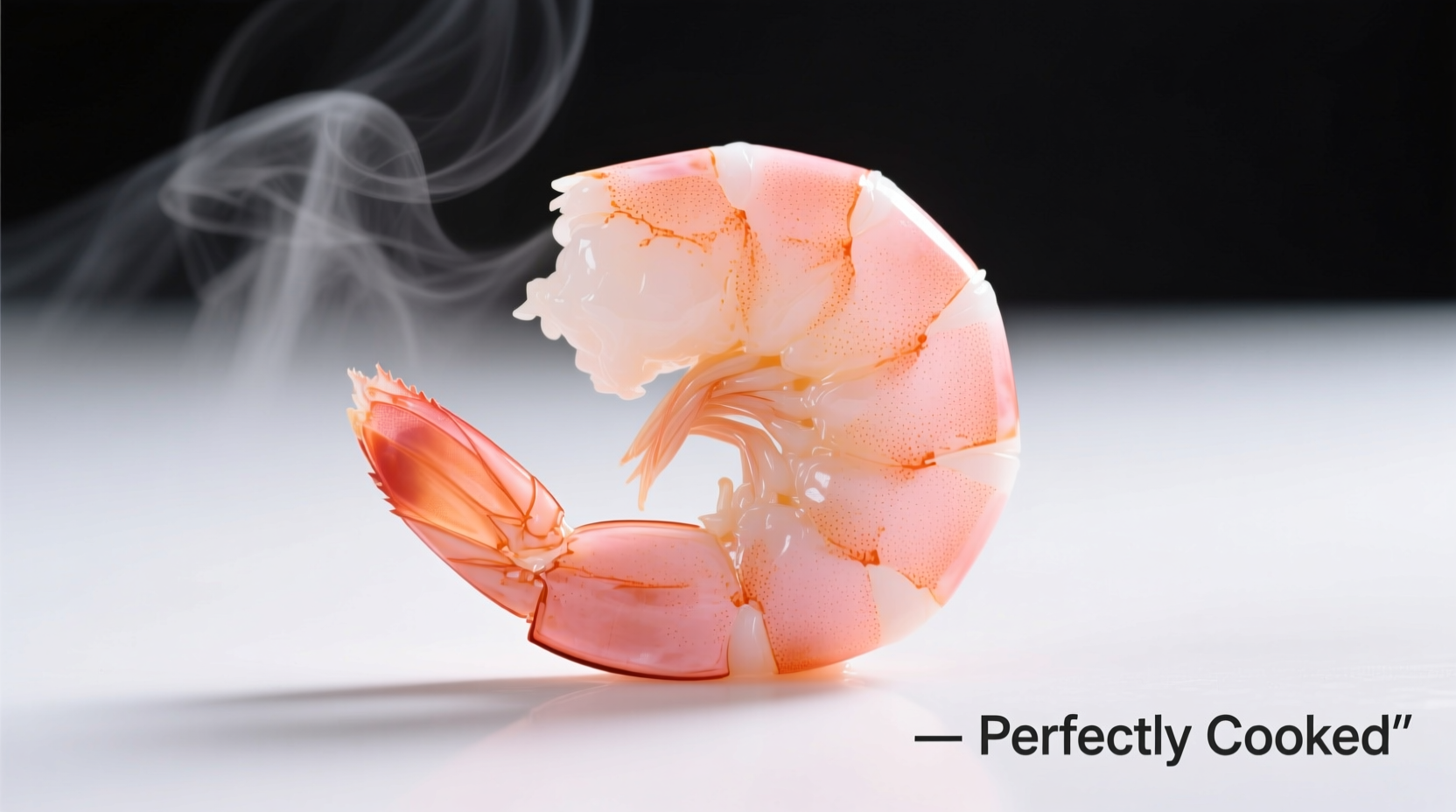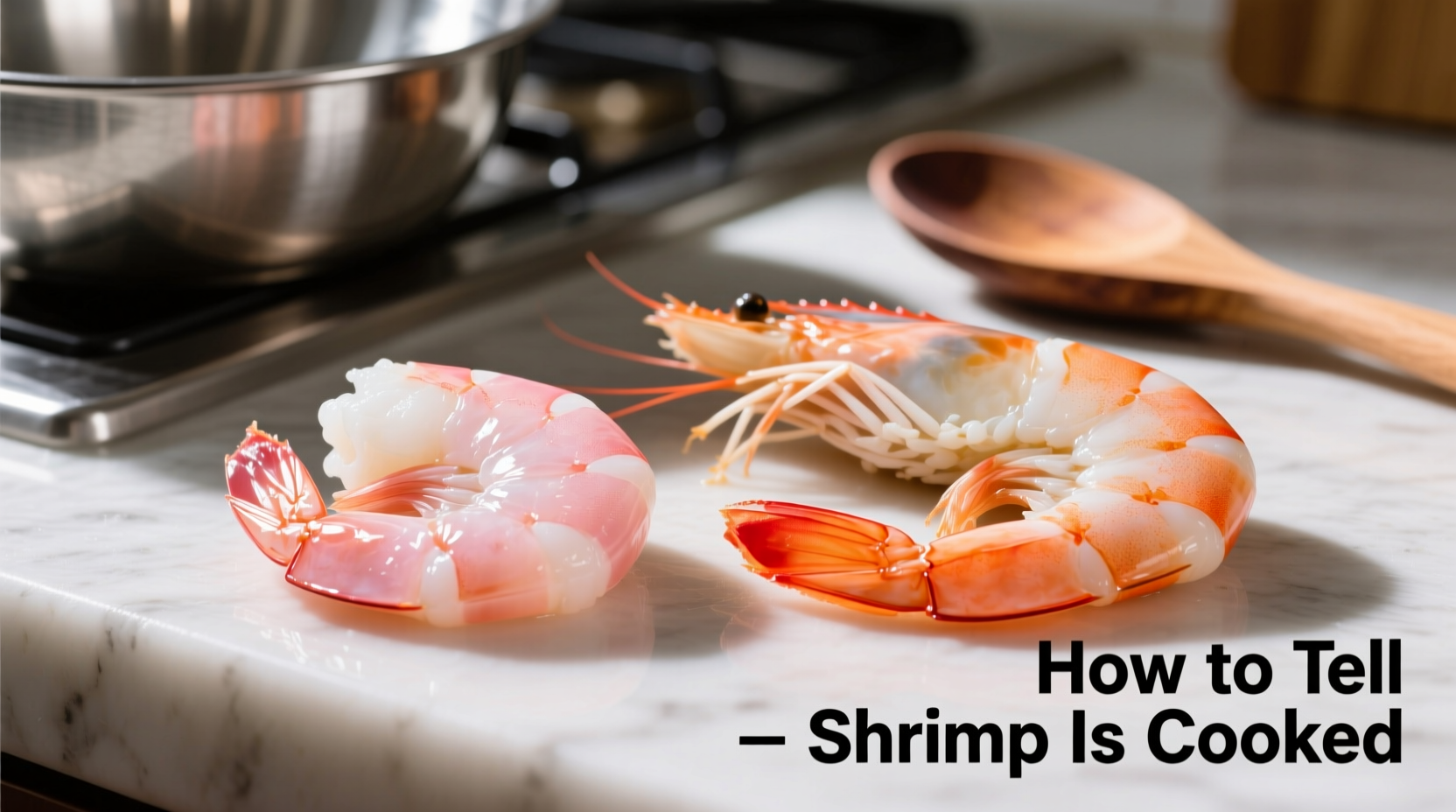Visual Indicators: The Color and Shape Transformation
Watching shrimp transform during cooking provides the most reliable visual cues. Raw shrimp appear grayish-translucent with a straight or slightly curved shape. As they cook, three distinct visual changes occur:
| Cooking Stage | Color | Shape | Opacity |
|---|---|---|---|
| Raw | Grayish-blue, translucent | Straight or slightly curved | Completely translucent |
| Perfectly Cooked | Bright pink/red exterior, opaque white interior | Loose 'C' shape | Fully opaque |
| Overcooked | Bright pink throughout | Tight 'O' shape | Dry, chalky appearance |
This transformation occurs because heat causes the protein structure in shrimp to denature. According to the U.S. Food and Drug Administration, properly cooked seafood reaches an internal temperature that destroys harmful bacteria while maintaining optimal texture.
Tactile and Temperature Verification
While visual cues are helpful, combining them with tactile and temperature checks ensures perfect results every time:
- Texture test: Gently press cooked shrimp with a fork or your finger. Properly cooked shrimp should feel firm but yield slightly, bouncing back when pressed. Undercooked shrimp feels soft and mushy, while overcooked shrimp feels hard and rubbery.
- Temperature check: Insert an instant-read thermometer into the thickest part of the shrimp. The USDA Food Safety and Inspection Service confirms seafood is safe to eat at 145°F (63°C), or when the flesh appears opaque and flakes easily with a fork.
- Internal appearance: Cut into one shrimp to check the center. Perfectly cooked shrimp has completely opaque white flesh throughout with no translucent areas.

Cooking Time Guidelines by Method
Cooking times vary based on method and shrimp size. These guidelines apply to medium-sized (31-40 count per pound) shrimp at room temperature:
- Boiling: 2-3 minutes in rapidly boiling salted water. Shrimp will float to the surface when nearly done.
- Sautéing: 1½-2½ minutes per side in hot oil over medium-high heat.
- Grilling: 2-3 minutes per side on a preheated grill (400-450°F).
- Baking: 8-12 minutes at 400°F depending on size and whether frozen.
Remember that shrimp continue cooking from residual heat after removal from the heat source. Always remove shrimp from heat when they're just shy of perfect, as carryover cooking will finish the process.
Avoiding Common Shrimp Cooking Mistakes
Even experienced cooks make these errors when preparing shrimp:
- Overcrowding the pan: When sautéing or grilling, overcrowding causes steaming instead of searing, resulting in uneven cooking and rubbery texture. Cook in batches if necessary.
- Not accounting for size differences: Jumbo shrimp require 30-50% more cooking time than medium shrimp. Sort by size before cooking for consistent results.
- Thawing improperly: Never thaw shrimp at room temperature. The FDA recommends thawing in the refrigerator overnight or under cold running water for 10-15 minutes.
- Ignoring carryover cooking: Removing shrimp when they appear slightly underdone prevents the rubbery texture of overcooked shrimp.
Special Considerations for Different Shrimp Types
Various factors affect cooking time and visual indicators:
- Frozen vs. fresh: Frozen shrimp require 20-30% longer cooking time. Always thaw properly before cooking for best results.
- Wild-caught vs. farm-raised: Wild shrimp often cook slightly faster due to lower water content.
- Peeled vs. shell-on: Shell-on shrimp take 1-2 minutes longer to cook and provide better flavor protection.
- High-altitude cooking: At elevations above 3,000 feet, increase cooking time by 15-25% as water boils at lower temperatures.
Why Proper Shrimp Cooking Matters for Food Safety
Undercooked shrimp pose a serious food safety risk. According to a CDC report on seafood safety, raw or undercooked shrimp may contain Vibrio bacteria, which causes approximately 80,000 illnesses annually in the United States. Proper cooking destroys these pathogens while maintaining the delicate texture that makes shrimp so appealing.
Practical Tips for Perfect Shrimp Every Time
Implement these professional techniques for consistently excellent results:
- Pat shrimp completely dry before cooking to ensure proper searing
- Season just before cooking to prevent moisture release
- Use high heat for quick cooking that preserves moisture
- Prepare all ingredients beforehand (shrimp cook too fast for mid-process prep)
- Remove from heat when shrimp are 80% opaque—they'll finish cooking off-heat











 浙公网安备
33010002000092号
浙公网安备
33010002000092号 浙B2-20120091-4
浙B2-20120091-4